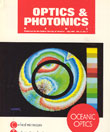
July 1991 Issue
Feature Articles
The science Of oceanic optics began at 4 p.m., 20 April 1865, when an Italian priest lowered a white disk over the side of a Papal sloop to determine water clarity in the Tyrrhenian Sea by measuring the depth at which the disk disappeared from sight Oceanic optics— underwater optics including effects of the sea surface it-Self--has since developed into a field of vigorous basic and applied research. The importance of this research is seen in several recent actions. The Optical Society of America has expanded its technical group on Atmospheric Optics to Atmospheric and Oceanic Optics. The American Society of Limnology and Oceanography now recognizes optical oceanography as the equal of the traditional physical, bioipgical, chemical, and geological subdisciplines of oceanography. And most significantly, in 1988 the U.S. Navy established the Oceanic Optics Program at the Office of Naval Research. This program provides a federal source of funding dedicated to basic research in oceanic optics.
by Curtis MobleyOSA funds standards writing activities
This month we report on several recent, tangible actions taken by major organizations involved with optics. The most recent is the decision by the OSA Board of Directors to give $15,000 as start-up funding for domestic optical standards work, with the understanding that the optics industry contributes like or greater sums in following years. This money will supplement the funds already being given by the American Ceramic Society (ACS), the Scientific Apparatus Manufacturers Association (SAMA), the American Precision Optical Manufacturers Association (APOMA), the Optical Laboratories Association (OLA), and the Laser and Electro-optical Manufacturers Association (LEOMA).
by Robert E. ParksHolograms have become an everyday experience because of two technologies: the "white-light transmission" or "rainbow" hologram that is viewable in white light, and the inexpensive replication of holograms by embossing in plastic. Here, we will examine the first of these as might be found in a typical "silvery blob" hologram from cereal box, T-shirt, or magazine cover, and try to address some of the questions about them that I get asked most often. Find a hologram that has large areas that appear in a single color, as some multicolor holograms are too complex for these experiments.
by Stephen A. BentonConfocal microscopy is one of those wonderful concepts that seem obvious when pointed out. It's not surprising that we can recognize the idea in many of the approaches to optical instrumentation that we all invent and use. So why has it suddenly appeared in our midst? I think the answer is, in part, that the laser and modern scanning techniques have enabled it. But the rest of the answer is that confocal microscopy isn't new: Minsky was issued a patent on the confocal microscope in 1957, and one implementation even uses incandescent light and spinning (Nipkow) disks.
by Robert H. Webb

![Manual probe system with needles for test of semiconductor on silicon wafer. [A. Morozov / Getty]](https://opnmedia.blob.core.windows.net/$web/opn/media/images/articles/2025/1125/departments/202511-cover-web.jpg?ext=.jpg)
![Researcher Clara Saraceno in the lab. [Image by Carsten Behler Photography]](https://opnmedia.blob.core.windows.net/$web/opn/media/images/articles/2025/1025/departments/202510-cover-web.jpg?ext=.jpg)
